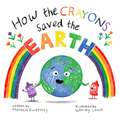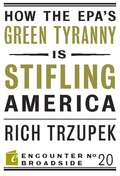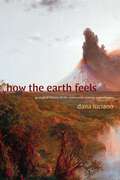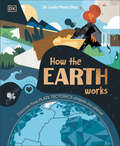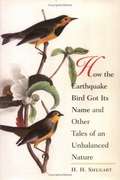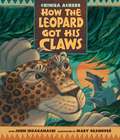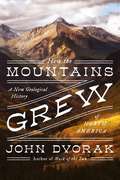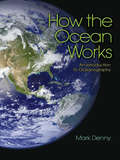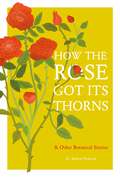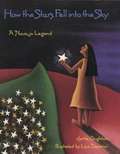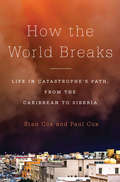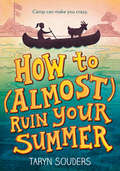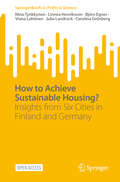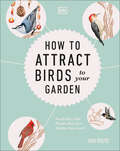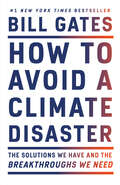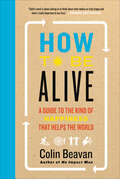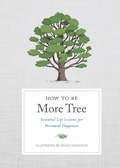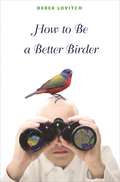- Table View
- List View
How the Crayons Saved the Earth (How the Crayons Saved #5)
by Monica SweeneyWhat can crayons do to save the planet?Something is happening to our big green and blue Earth! Pollution is making it hard for plants to grow, for animals to play, and for oceans to stay clean. But what can anyone do about it? On a yucky, smoggy day, a box of seven special crayons steps up to help! These peppy crayons are on another adventure to bring friendship, teamwork, and thoughtfulness to the world—but this time, it&’s the world that needs help. With their unique personalities, quirky attitudes, and stick-to-itiveness, this rainbow of friends puts their heads and hearts together to find a way to save the Earth. How the Crayons Saved the Earth is a colorful book about the environment from the plucky crayons who brought you the How the Crayons Saved the Rainbow series. How the Crayons Saved the Earth reminds kids about the importance of taking care of the Earth and that teamwork and determination can make a real difference.
How the Dog Became the Dog: From Wolves to Our Best Friends
by Mark DerrThat the dog evolved from the wolf is an accepted fact of evolution and history, but the question of how wolf became dog has remained a mystery, obscured by myth and legend. How the Dog Became the Dog posits that dog was an evolutionary inevitability in the nature of the wolf and its human soul mate. The natural temperament and social structure of humans and wolves are so similar that as soon as they met on the trail they recognized themselves in each other. Both are highly social, accomplished generalists, and creatures of habit capable of adapting? homebodies who like to wander. How the Dog Became the Dog presents domestication of the dog as a biological and cultural process that began in mutual cooperation and has taken a number of radical turns. At the end of the last Ice Age the first dogs emerged with their humans from refuges against the cold. In the eighteenth century, humans began the drive to exercise full control of dog reproduction, life, and death to complete the domestication of the wolf begun so long ago. .
How the EPA's Green Tyranny is Stifling America
by Rich TrzupekThe relationship between environmental regulation and economic growth has gone from dysfunctional to disastrous under the leadership of Barack Obama's USEPA Administrator, Lisa Jackson. Jackson's EPA has assumed broad new powers and promulgated sweeping new regulations unlike anything that America has seen since the Clean Air Act and Clean Water Act were signed into law forty years ago. While much of the public has focused on the EPA's plans to regulate greenhouse gas emissions, the Agency's power grab extends into far more areas of society and the economy than fossil fuel use alone.Rich Trzupek explains why Obama's EPA is different and more dangerous, than any other since the Agency was created forty years ago. From the oceans to consumer products, from the manufacturing line to the showroom floor, the tentacles of this EPA are silently creeping into more and more parts of our lives as Lisa Jackson smilingly assures the nation that everything the EPA does generates revenue rather than costing industry billions of dollars and America hundreds of thousands of jobs.
How the Earth Feels: Geological Fantasy in the Nineteenth-Century United States (ANIMA: Critical Race Studies Otherwise)
by Dana LucianoIn How the Earth Feels Dana Luciano examines the impacts of the new science of geology on nineteenth-century US culture. Drawing on early geological writings, Indigenous and settler accounts of earthquakes, African American antislavery literature, and other works, Luciano reveals how geology catalyzed transformative conversations regarding the intersections between humans and the nonhuman world. She shows that understanding the earth’s history geologically involved confronting the dynamic nature of inorganic matter over vast spans of time, challenging preconceived notions of human agency. Nineteenth-century Americans came to terms with these changes through a fusion of fact and imagination that Luciano calls geological fantasy. Geological fantasy transformed the science into a sensory experience, sponsoring affective and even erotic connections to the matter of the earth. At the same time, it was often used to justify accounts of evolution that posited a modern, civilized, and Anglo-American whiteness as the pinnacle of human development. By tracing geology’s relationship with biopower, Luciano illuminates how imagined connections with the earth shaped American dynamics of power, race, and colonization.
How the Earth Works: Discover How Plate Tectonics Shapes Our Planet
by Dr. Lucia Perez-DiazSee below the surface of Earth and discover the secrets that lie beneath our feet in this fascinating book about Earth.Author Dr. Lucía Pérez-Díaz offers budding young Earth scientists aged 7-9 everything they need to decode the puzzle that is planet Earth.On a journey like no other, children will learn what our planet was once like, how and why it has changed, and what the future may hold. They will adventure through earthquakes and over towering mountains to learn about our landscapes and unlock clues to Earth’s long history.This Earth science book for children offers: A unique adventure through Earth for kids, covering the past, present and future of our planet’s geography.An in-depth look at the trending topics of Earth and the environment in relation to rising global temperatures.Information on topics like plate tectonics, and how human actions and the climate affect this.How the Earth Works digs into all that happens beneath our feet in an accessible and lively manner. The pages of this book are charged with Dr. Lucía Pérez-Díaz’s passion and expertise, as she helps us to explore the inner workings of our planet. Filled with dynamic illustrations, this geology book takes on plate tectonics in a digestible and adventurous way that you don’t want to miss!
How the Earthquake Bird Got Its Name: And Other Tales of an Unbalanced Nature
by H. H. ShugartAlthough people have been altering earth's landscapes to some extent for tens of thousands of years, humankind today is causing massive changes to the planet. Such widespread environmental change is accompanied by accelerating rates of species extinction. In this book, noted ecologist H. H. Shugart presents important ecological concepts through entertaining animal parables. He tells the stories of particular birds and mammals--the packrat, ivory-billed woodpecker, penguin, dingo, European rabbit, and others--and what their fates reveal about the interactions between environmental change and the extinctions or explosions of species populations. Change is the root of many planetary problems, but it is also an intrinsic feature of our living planet. Shugart explores past environmental change, discusses the non-existence of a "balance of Nature," and documents how human alterations have affected plants, soils, and animals. He looks with hope toward a future in which thoughtful people learn-and use-ecological science to protect the landscapes upon which terrestrial creatures depend.
How the Government Got in Your Backyard: Superweeds, Frankenfoods, Lawn Wars, and the (Nonpartisan) Truth About Environmental Policies
by Jeff Gillman Eric HeberligBiotechnology—the future or a genetic time bomb? Renewable fuels—the key to cleaner air or just corporate welfare? Greenhouse gasses—baking the earth to death or just a needless worry? Plant patents—improving gardens and farms or just profiteering? When you stop to think about it, the government has its hand in every important environmental issue. And with the left and the right raucously disagreeing about whether the government’s policies are for good or for evil, it’s impossible for a concerned citizen to know what to think.How the Government Got in Your Backyard distills the science, the politics, and the unbiased, nonpartisan truth behind hot-button environmental issues from pesticides to global warming. By clearly representing what the left says, what the right says, what the science is, and what the facts are, Gillman and Heberlig don’t set out to provide the answer—they light the path so concerned citizens can uncover their own true and informed opinion. In this season of political discontent, the unbiased truth about environmental policies—free of political agendas—is as refreshing as it is fascinating.How the Government Got in Your Backyard is not for Republicans or Democrats, liberals or conservatives. It’s for anyone who is ready to get to the bottom line.
How the Leopard got his Claws
by Chinua AchebeIn the beginning, all the animals lived as friends. Their king, the leopard, was strong but gentle and wise. Only Dog had sharp teeth, and only he scoffed at the other animals’ plan to build a common shelter for resting out of the rain. But when Dog is flooded out of his own cave, he attacks the leopard and takes over as king. And it is then, after visiting the blacksmith’s forge and knocking on Thunder’s door, that the angry leopard returns to regain his throne by the menace of his own threatening new claws. In a riveting fable for young readers about the potency and dangers of power taken by force, Nigerian writer Chinua Achebe, author of Things Fall Apart, evokes themes of liberation and justice that echo his seminal novels about post-colonial Africa.
How the Mountains Grew: A New Geological History of North America
by John DvorakThe incredible story of the creation of a continent—our continent— from the acclaimed author of The Last Volcano and Mask of the Sun.The immense scale of geologic time is difficult to comprehend. Our lives—and the entirety of human history—are mere nanoseconds on this timescale. Yet we hugely influenced by the land we live on. From shales and fossil fuels, from lake beds to soil composition, from elevation to fault lines, what could be more relevant that the history of the ground beneath our feet? For most of modern history, geologists could say little more about why mountains grew than the obvious: there were forces acting inside the Earth that caused mountains to rise. But what were those forces? And why did they act in some places of the planet and not at others? When the theory of plate tectonics was proposed, our concept of how the Earth worked experienced a momentous shift. As the Andes continue to rise, the Atlantic Ocean steadily widens, and Honolulu creeps ever closer to Tokyo, this seemingly imperceptible creep of the Earth is revealed in the landscape all around us. But tectonics cannot—and do not—explain everything about the wonders of the North American landscape. What about the Black Hills? Or the walls of chalk that stand amongst the rolling hills of west Kansas? Or the fact that the states of Washington and Oregon are slowly rotating clockwise, and there a diamond mine in Arizona? It all points to the geologic secrets hidden inside the 2-billion-year-old-continental masses. A whopping ten times older than the rocky floors of the ocean, continents hold the clues to the long history of our planet. With a sprightly narrative that vividly brings this science to life, John Dvorak's How the Mountains Grew will fill readers with a newfound appreciation for the wonders of the land we live on.
How the New Deal Built Florida Tourism: The Civilian Conservation Corps and State Parks
by David J. NelsonFlorida Historical Society Rembert Patrick Award Florida Book Awards, Silver Medal for Florida Nonfiction Countering the conventional narrative that Florida’s tourism industry suffered during the Great Depression, this book shows that the 1930s were, in reality, the starting point for much that characterizes modern Florida’s tourism. David Nelson argues that state and federal government programs designed to reboot the economy during this decade are crucial to understanding the state today. Nelson examines the impact of three connected initiatives—the federal New Deal, its Civilian Conservation Corps program (CCC), and the CCC’s creation of the Florida Park Service. He reveals that the CCC designed state parks to reinforce the popular image of Florida as a tropical, exotic, and safe paradise. The CCC often removed native flora and fauna, introduced exotic species, and created artificial landscapes that were then presented as natural. Nelson discusses how Florida business leaders benefitted from federally funded development and the ways residents and business owners rejected or supported the commercialization and shifting cultural identity of their state. A detailed look at a unique era in which the state government sponsored the tourism industry, helped commodify natural resources, and boosted mythical ideas of the “Real Florida” that endure today, this book makes the case that the creation of the Florida Park Service is the story of modern Florida.
How the Ocean Works
by Mark DennyThe world's oceans account for roughly 71 percent of the planet's surface and 99 percent of its livable volume. Any study of this huge habitat requires a solid foundation in the principles that underlie marine biology and physical and chemical oceanography, yet until now undergraduate textbooks have largely presented compilations of facts rather than explanations of principles. How the Ocean Works fills this gap, providing a concise and accessible college-level introduction to marine science that is also ideal for general readers. How are winds and currents driven? What is the dilemma of the two-layered ocean? Mark Denny explains key concepts like these in rich and fascinating detail. He explores early scientific knowledge of oceans, photosynthesis, trophic interactions and energy flow, and the impacts of human activities on marine and atmospheric systems. Focusing each chapter on a major topic and carefully explaining the principles and theory involved, Denny gives readers the conceptual building blocks needed to develop a coherent picture of the living ocean. How the Ocean Works is an indispensable resource that teaches readers how to think about the ocean--its biology, mechanics, and conservation.Provides a concise, up-to-date introduction to marine science Develops the conceptual basis needed to understand how the ocean works Explains fundamental principles and theory Includes color illustrations and informative diagrams Serves as a college textbook and a reference for general readers
How the Rose Got Its Thorns: And Other Botanical Stories
by Dr Andrew OrmerodHave you ever wondered why the rose has thorns and other flowers don't; why the daffodil is the colour it is; or why some plants have shiny leaves and others matt?How The Rose Got its Thorns reveals the inner workings of our favourite flowers and trees. Designed to help gardeners, both novice and experienced, better understand how plants grow, the book is easy to navigate - it is divided into 50 chapters, each one a story.Accompanied by specially commissioned colour illustrations, each chapter explains the science behind how plants work and the extraordinary processes they have evolved: such as protecting themselves from predators using chemicals; attracting pollinators using scent, shape and colour; growing in low or high temperatures; their relationship with the wind; the size and pattern of their leaves; the distribution of their seeds and survival strategies; their relationship with insects; how they allocate their resources; and how they retain water efficiently.This delightful and intriguing book offers readers an accessible way to better understand how our plants evolved into the species of today.
How the Rose Got Its Thorns: And Other Botanical Stories
by Dr Andrew OrmerodHave you ever wondered why the rose has thorns and other flowers don't; why the daffodil is the colour it is; or why some plants have shiny leaves and others matt?How The Rose Got its Thorns reveals the inner workings of our favourite flowers and trees. Designed to help gardeners, both novice and experienced, better understand how plants grow, the book is easy to navigate - it is divided into 50 chapters, each one a story.Accompanied by specially commissioned colour illustrations, each chapter explains the science behind how plants work and the extraordinary processes they have evolved: such as protecting themselves from predators using chemicals; attracting pollinators using scent, shape and colour; growing in low or high temperatures; their relationship with the wind; the size and pattern of their leaves; the distribution of their seeds and survival strategies; their relationship with insects; how they allocate their resources; and how they retain water efficiently.This delightful and intriguing book offers readers an accessible way to better understand how our plants evolved into the species of today.
How the Stars Fell into the Sky: A Navajo Legend
by Lisa Desimini Jerrie OughtonThis retelling of a Navajo folktale explains how First Woman tried to write the laws of the land using stars in the sky, only to be thwarted by the trickster Coyote.
How the World Breaks: Life in Catastrophe's Path, from the Caribbean to Siberia
by Stan Cox Paul CoxWe've always lived on a dangerous planet, but its disasters aren't what they used to be. How the World Breaks gives us a breathtaking new view of crisis and recovery on the unstable landscapes of the Earth's hazard zones. Father and son authors Stan and Paul Cox take us to the explosive fire fronts of overheated Australia, the future lost city of Miami, the fights over whether and how to fortify New York City in the wake of Sandy, the Indonesian mud volcano triggered by natural gas drilling, and other communities that are reimagining their lives after quakes, superstorms, tornadoes, and landslides.In the very decade when we should be rushing to heal the atmosphere and address the enormous inequalities of risk, a strange idea has taken hold of global disaster policy: resilience. Its proponents say that threatened communities must simply learn the art of resilience, adapt to risk, and thereby survive. This doctrine obscures the human hand in creating disasters and requires the planet's most beleaguered people to absorb the rush of floodwaters and the crush of landslides, freeing the world economy to go on undisturbed. The Coxes' great contribution is to pull the disaster debate out of the realm of theory and into the muck and ash of the world's broken places. There we learn that change is more than mere adaptation and life is more than mere survival. Ultimately, How the World Breaks reveals why--unless we address the social, ecological, and economic roots of disaster--millions more people every year will find themselves spiraling into misery. It is essential reading for our time.
How to (Almost) Ruin Your Summer
by Taryn SoudersTop Three Reasons Camp Minnehaha is The Worst1. The spiders (wayyyy too many legs)2. King Arthur (a rampaging goat intent on my destruction)3. Victoria a.k.a The Diva (an evil cabin mate obsessed with French beauty products and my humiliation)Chloe McCorkle knew a summer camp where you had to learn a career was a bad idea. She tried to tell her parents, but they just had to go on vacation to Alaska and ship her off for two weeks. It's not ideal, but she's going to try to make the best of it. She might even learn some skills that will help her make money for the new bike she's been eyeing. But Chloe quickly discovers there's only one area at which she excels; she manages to get more demerits than anyone else in camp...
How to Achieve Sustainable Housing?: Insights from Six Cities in Finland and Germany (SpringerBriefs in Political Science)
by Björn Egner Nina Tynkkynen Linnéa Henriksson Viena Lahtinen Julia Landrock Carolina GrönbergThis Brief provides an integrated study of housing and climate policy at the local level. Drawing from an empirical research project across six cities in Finland and Germany, the book explores the degree of integration between housing and climate policy in local government, specifically focusing on the level of awareness of local politicians of the interdependency of the two policy areas. Using document analysis as well as extensive interviews with local politicians, the Brief explains which views local councillors hold about the responsibilities of their municipality in housing and climate policy, how the two fields influence each other and what councillors see as obstacles for joint decision making in both fields. The book looks at housing from a broader perspective, linking housing not only to the number of dwellings, zoning, or construction, but also to the environment, communities and transport. Offering policy advice on how to integrate these sectors and pursue sustainable housing from a holistic perspective, this Brief will be of use to researchers and policymakers interested in housing policy, climate policy, local politics, urban politics, and sustainability. This book is open access, which means that you have free and unlimited access.
How to Attract Birds to Your Garden: Foods they like, plants they love, shelter they need
by Dan RouseHelp your local wild birds by providing them with a safe garden environmentMake a difference to your local birdlife. Help reverse the decline in bird numbers by creating a haven in which they will thrive. It's a win-win. Provide the best shelter, feeding, and nesting opportunities for them and then you can reap the rewards as they sing and entertain.No need to be an expert gardener already, or to break the bank - many of the most beneficial features can be installed easily and cheaply, and many you can build yourself or upcycle to be eco-friendly.
How to Avoid a Climate Disaster: The Solutions We Have and the Breakthroughs We Need
by Bill GatesIn this urgent, singularly authoritative book, Bill Gates sets out a wide-ranging, practical--and accessible--plan for how the world can get to zero greenhouse gas emissions in time to avoid an irreversibleclimate catastrophe.Bill Gates has spent a decade investigating the causes and effects of climate change. With the help and guidance of experts in the fields of physics, chemistry, biology, engineering, political science and finance, he has focused on exactly what must be done in order to stop the planet's slide toward certain environmental disaster. In this book, he not only gathers together all the information we need to fully grasp how important it is that we work towardnet-zero emissions of greenhouse gases but also details exactly what we need to do to achieve this profoundly important goal. He gives us a clear-eyed description of the challenges we face. He describes the areas in which technology is already helping to reduce emissions; where and how the current technology can be made to function more effectively; where breakthrough technologies are needed, and who is working on these essential innovations. Finally, he lays out a concrete plan for achieving the goal of zero emissions--suggesting not only policies that governments should adopt, but what we as individuals can do to keep our government, our employers and ourselves accountable in this crucial enterprise.As Bill Gates makes clear, achieving zero emissions will not be simple or easy to do, but by following the guidelines he sets out here, it is a goal firmly within our reach.
How to Avoid a Climate Disaster: The Solutions We Have and the Breakthroughs We Need
by Bill GatesIn this urgent, authoritative book, Bill Gates sets out a wide-ranging, practical--and accessible--plan for how the world can get to zero greenhouse gas emissions in time to avoid a climate catastrophe. <P><P>Bill Gates has spent a decade investigating the causes and effects of climate change. With the help of experts in the fields of physics, chemistry, biology, engineering, political science, and finance, he has focused on what must be done in order to stop the planet's slide to certain environmental disaster. In this book, he not only explains why we need to work toward net-zero emissions of greenhouse gases, but also details what we need to do to achieve this profoundly important goal. <P><P>He gives us a clear-eyed description of the challenges we face. Drawing on his understanding of innovation and what it takes to get new ideas into the market, he describes the areas in which technology is already helping to reduce emissions, where and how the current technology can be made to function more effectively, where breakthrough technologies are needed, and who is working on these essential innovations. Finally, he lays out a concrete, practical plan for achieving the goal of zero emissions--suggesting not only policies that governments should adopt, but what we as individuals can do to keep our government, our employers, and ourselves accountable in this crucial enterprise. <P><P>As Bill Gates makes clear, achieving zero emissions will not be simple or easy to do, but if we follow the plan he sets out here, it is a goal firmly within our reach. <P><P><b>A New York Times Bestseller</b>
How to Be Alive: A Guide to the Kind of Happiness That Helps the World
by Colin Beavan“This is the book where self-help turns into helping the world—and then turns back into helping yourself find a better life. Fascinating and timely!”—Bill McKibben, author of Eaarth: Making a Life on a Tough New PlanetWhat does it take to achieve a successful and satisfying life? Not long ago, the answer seemed as simple as following a straightforward path: college, career, house, marriage, kids, and a secure retirement. Not anymore. Staggering student loan debt, sweeping job shortages, a chronically ailing economy—plus the larger issues of global unrest, poverty, and our imperiled environment—make the search for fulfillment more challenging. And, as Colin Beavan, activist and author of No Impact Man, proclaims, more exciting.In this breakthrough book, Beavan extends a hand to those seeking more meaning and joy in life even as they engage in addressing our various world crises. How to Be Alive nudges the unfulfilled toward creating their own version of the Good Life—a life where feeling good and doing good intersect. He urges readers to reexamine the “standard life approaches” to pretty much everything and to experiment with life choices that are truer to their values, passions, and concerns.How do you stop placing limits on your potential impact? How do you make your choices really matter in everything from your clothing purchases to your career? How do you find the people who will most support you in your quest for a good life? To answer these questions and more, Beavan draws on classic literature and philosophy; surprising new scientific findings; and the uplifting personal stories of real-life “lifequesters”—people who are breaking away from those old broken paths, blazing fresh trails, and reveling in every step along the way.“There is a movement afoot for a better life and Colin Beavan is its prophet, with a new book as powerful as his already classic No Impact Man.”—John de Graaf, coauthor of Affluenza
How to Be More Tree: Essential Life Lessons for Perennial Happiness
by Potter GiftA beautifully illustrated celebration of the wisdom of trees and what they can teach us about everyday life, from basking in the sun to weathering the storm.This sweet and informative book brings together fifty-nine universal life lessons taken from the infinite wisdom of trees. As you learn about dozens of trees, from the Acai palm to the Yoshino cherry, you'll find that their means of survival are not so different from ours. The juniper tree proves that it's possible to flourish anywhere as long as we put down strong roots. A mountain hemlock finds strength basking in the sun while a black walnut's sturdiness comes from its thick, steely core. The hawthorn demonstrates resilience as it adapts to strong winds and storms by finding balance in its roots. Trees have many more lessons to offer, from letting go of the past, to branching out, to resisting the urge to overstretch ourselves. With detailed illustrations and advice for lifelong happiness, How to Be More Tree is an essential companion for all those moments when we're having trouble seeing the forest for the trees.
How to Be a Better Birder
by Derek LovitchThe essential tools you need to become a better birderThis unique illustrated handbook provides all the essential tools you need to become a better birder. Here Derek Lovitch offers a more effective way to go about identification—he calls it the "Whole Bird and More" approach—that will enable you to identify more birds, more quickly, more of the time. He demonstrates how to use geography and an understanding of habitats, ecology, and even the weather to enrich your birding experience and help you find something out of the ordinary. Lovitch shows how to track nocturnal migrants using radar, collect data for bird conservation, discover exciting rarities, develop patch lists—and much more.This is the ideal resource for intermediate and advanced birders. Whether you want to build a bigger list or simply learn more about birds, How to Be a Better Birder will take your birding skills to the next level.Explains the "Whole Bird and More" approach to bird identificationDemonstrates how to use geography, habitats, ecology, and the weather to be a better birderShows how to bird at night using radar, collect conservation data, develop patch lists—and moreOffers essential tools for intermediate and advanced birders
How to Be a Climate Optimist: Blueprints for a Better World
by Chris TurnerFrom the National Business Book Award winner and GG finalist, a very different book about facing the climate crisis, and what awaits us on the other side.Chris Turner has reported from the places where the sustainable future first emerged—from green islands in Denmark and green office parks in southern India, to solar panel factories in California and idealistic intentional communities from Scotland to New Mexico. Here, he condenses the first quarter century of the global energy transition into bite-sized chunks of optimistic reflection and reportage, telling a story of a planet in peril and a global effort already beginning to save it. This is a book that moves past the despair and futile anger over ecological collapse and harnesses that passion toward the project of building a twenty-first century quality of life that surpasses the twentieth-century version in every way. How to Be a Climate Optimist overflows with possibility in a moment of great panic, upheaval and uncertainty over a world on fire.
How to Be a Cloud Spotter (Fountas & Pinnell Classroom)
by Jane GerverHeads Up! We're used to seeing clouds in the sky: high clouds, low clouds, thin or fluffy clouds, dark or white clouds. But there's much more to know about clouds and the part they play in our lives. NIMAC-sourced textbook
